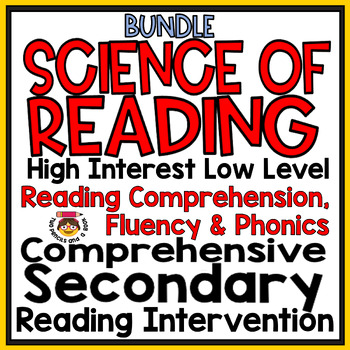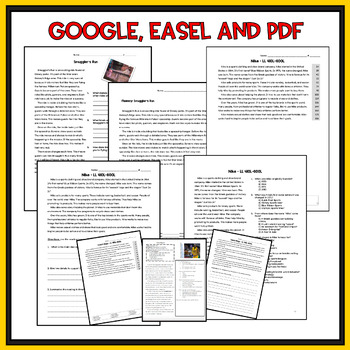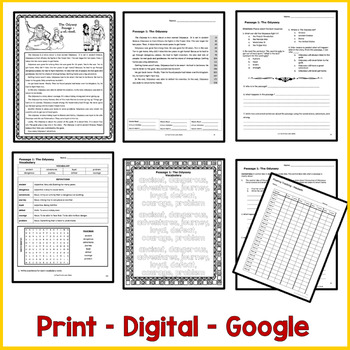Intervention Program Hi Low Science of Reading Comprehension, Fluency, & Phonics
- Zip
- Google Apps™
- Easel Activity

Products in this Bundle (80)
showing 1-5 of 80 products
Bonus
Description
Giant Intervention Bundle. High interest - low level reading comprehension, fluency and phonics program for secondary students. This program is perfect for older struggling readers. Print and digital phonics, multi-syllable word work, intervention reading comprehension, fluency and word work.
Download the preview for details of files included.
Contains
- PDFs to print for packets, classroom work or take home.
- GOOGLE Slides
- Easel which can be uploaded to Google and other platforms
These are HIGH INTEREST-LOW LEVEL READABILITY PASSAGES – perfect for Distance, Digital, hybrid and Classroom learning. Because students are able to read the passages on their own and complete quick comprehension and standards-based assessments, they are great for centers, homework or distance learning.
Check out the preview!
This program works for resource, sped, whole class, RTI, summer school, and more. If you are using this program with more than one student – partner up. Partnering students is engaging and lets everyone participate. This program helps students build confidence while reinforcing learning; additionally, by reading, tracking and reading again, student exposure to each passage is maximized.
+++++++++++++++++++++++++++++++++++++++++++++++++++++++++++++++++++++++
Multisyllabic Word Reading Research
To progress in reading, students must have strategies for decoding big words. From fifth grade on, the average student encounters about 10,000 new words each year. Most of these words are multisyllabic. (Nagy and Anderson 1984).
It is helpful for students to be familiar with the common rules for syllable division. Knowing these rules and being able to apply them flexibly will help students decode longer multisyllabic words. (Carreker 2005; Henry 2010b)
According to Shefelbine and Calhoun 1991, “Low decoders, correctly pronounced fewer affixes and vowel sounds, disregarded large portions of letter information and were two to four times more likely to omit syllables.”
Several studies have shown that teaching students strategies for decoding longer words improves their decoding ability. (Archer et al. 2006; Archer 2018.)
Recognizing a Decoding Problem Symptoms:
- Guesses at words from context
- Avoids sounding out new words
- Confuses similar sounds, symbols, and/or words
- Inaccurate reading of nonsense words or words out of context
- Inadequate sight word vocabulary
- Tires easily, looks away, is easily frustrated, hates to read
These strategies build word recognition and build strong readers:
- Phonemic Awareness
- Vocabulary/Morphology
- Fluency
Teaching Syllabication
- Syllabication instruction teaches a struggling reader strategies to decode multi-syllable words quickly.
- Students learn to systematically break a multisyllable work into small manageable syllables, identify the vowel sounds within each syllable and “sound out” the word syllable by syllable.
- As students progress through the lessons, they will internalize the process and apply it easily and effortlessly.
- They will become faster, more efficient and fluent readers who comprehend at a higher level.
Fluency Research
To be considered “on level” in reading fluency, students should be able to read aloud an unrehearsed passage, (i.e., either narrative or expository, fiction or non-fiction that is 200 to 300 words in length) from a grade-level text, with at least 95% accuracy in word reading. As students read aloud, their reading should sound as effortless as if they were speaking (Hasbrouck & Glaser, 2012.) This does not come easily for some students, which is why fluency practice is so essential.
In order to be considered fluent readers, students in grades 9 through 12 should be able to correctly read 150 words per minute (Hasbrouck & Tindal, 2006). In 2006 and again in 2010, Hasbrouck and Hasbrouck and Tindal (respectively) put forth that “[i]t is sufficient for students to read unpracticed, grade-level text at the 50th percentile of oral reading fluency norms” and that “…teachers do not need to have students read faster because there is no evidence that reading faster than the 50th percentile increases comprehension.” See chart below.
The best strategy for developing and improving reading fluency is to provide students with many opportunities to read the same passages orally several times. These exercises provide such opportunities. On each passage, there is space for reading fluency calculations. The best part is that the passages are quick and make it easy for students to read aloud repeatedly – and often – without taking up a lot of valuable classroom time. The activities can also be spread over several days.
+++++++++++++++++++++++++++++++++++++++++++++++++++++++++++++++++++++++
Please have a look at these Multi-Syllable Word Units for Older Reluctant Readers:
~~~~~~~~~~~~~~~~~~~~~~~~~~~~~~~~~~~~~~~~~~~~~~~~~~~~~~~~~~~~~~~~~~~~~~~~~~
This resource works well with...
BUNDLE: Giant Multi-Syllable Word Units VC/CV, VC/V, V/CV, & VCe: INTERVENTION
Intervention: Multi-Syllable Word Unit for Older Students VC/CV - Fluency Plus
Multi-Syllable Word TASK CARDS for Older Students VC/CV
Intervention: Multi-Syllable Word Unit for Older Students V/CV - Fluency Plus
Multi-Syllable Word TASK CARDS for Older Students V/CV
Multi-Syllable Word TASK CARDS for Older Students VC/V
Intervention: Multi-Syllable Word Unit for Older Students VC/V - Fluency Plus
More Specifically About the Resources Included: These High Interest, Low Level reading comprehension and fluency passages are engaging. They are perfect for older struggling readers and are aligned with the middle school and high school CCSS for English Language Arts.
These are HIGH INTEREST-LOW LEVEL READING COMPREHENSION PASSAGES. The research-based strategy of having students read the same passages multiple times to increase both fluency and comprehension – repeated reading – is the framework for these activities.
These high interest low level reading comprehension and fluency passages for older students are perfect for distance, digital, hybrid and classroom learning. The activities also work as bellringers, homework, RTI and for centers. The passages are designed for students to read on their own and complete quick comprehension assessments. The assessments contain four to five multiple-choice questions.
These passages, with reading comprehension assessments and fluency practice, that are high interest but at accessible reading levels. This resource is perfect for reluctant older readers who need reading practice but are put off by text that looks “young” or “babyish.”
The reading techniques used in this resource are research-based and appeal to students in grades 5 through 12. Lexile levels are included.
*Repeated reading research: The idea of repeated reading emerged as a result of the writings of S. Jay Samuels (1979) and Carol Chomsky (1978). They found, in separate studies, that engaging people in repeatedly reading texts aloud improved reading ability. Scientific studies (e.g., LaBerge & Samuels) revealed the importance of “automaticity” of reading. Readers must be able to decode without thinking about decoding. We only have so much thinking space available. The more cognitive space devoted to figuring out words, the less available to grasp the text's meaning. Samuel’s subsequent research in repeated reading proved that RR could help readers to gain automaticity and help readers master the art of reading words accurately and with sufficient speed.
Repeated Reading is a particular method proposed by S. Jay Samuels to develop decoding automaticity with struggling readers. In this approach, students are asked to read aloud short text passages (50-250 words) until they reach a criterion level of success (particular speed and accuracy goals). It is important to keep within this range so that when students reread, memory becomes a useful scaffold. The longer the text, the harder to carry over what was figured out on the first reading. Other research emphasized the importance of using texts that share a lot of vocabulary – these do. That way, when a student improves with one text, it is certain to immediately carry over to the next. The research suggests that three readings should be sufficient. Three readings and it is time to move on to another text. These fluency passages are meant to be read twice. The corresponding comprehension pieces once. That said – there is space for three fluency scores on the fluency pages as some teachers practice fluency separately.





